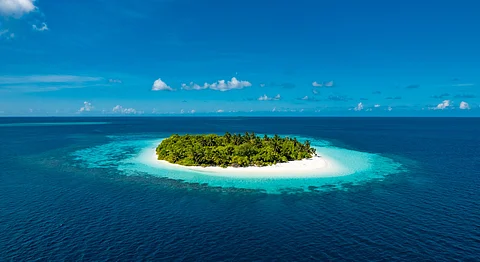

The world needs to invest $15.8 billion annually to achieve the 30x30 target of protecting 30 per cent of the global oceans by 2030, according to a new report. This figure represents approximately 0.5 per cent of annual global defence budgets.
However, current annual investment in ocean protection stands at a mere $1.2 billion, creating a substantial funding gap of $14.6 billion, according to the report The Ocean Protection Gap: Assessing Progress toward the 30x30 Target, prepared by a consortium of nongovernmental organisations and funders. The report comes ahead of the United Nations Ocean Conference 3 (UNOC3) to be held in France between June 9 and 13.
The 30x30 target is one of 23 goals outlined in the Kunming-Montreal Global Biodiversity Framework, adopted by 196 countries in 2022, to halt and reverse nature loss. It aims to conserve and manage at least 30 per cent of terrestrial, inland water, marine, and coastal areas through protected areas (PA) and other effective area-based conservation measures (OECMs).
Marine Protected Areas (MPAs) are defined regions managed for the long-term conservation of marine resources, ecosystems, or cultural heritage. OECMs are areas that effectively conserve biodiversity outside of designated protected areas.
The ocean plays a critical role in global ecosystems, generating half the oxygen we breathe, regulating climate by absorbing heat and storing carbon, and contributing $2.6 trillion in value annually — exceeding the Gross Domestic Product of Brazil or Canada. In 2023, ocean-based sectors such as shipping, tourism, fisheries, and marine energy accounted for 7 per cent of global trade in 2023, according to the United Nations Trade and Development (UNCTAD). But climate stress, policy fragmentation, and shifting trade dynamics are threatening future gains.
“The Ocean does not get enough attention. It’s the hardest working ally to support climate change. It is home to an incredible array of marine life. Billions of people rely on the ocean as their primarily food source,” Brian O'Donnell, Director of Campaign for Nature, said at the report launch.
According to the latest update from the World Database on Protected Areas (WDPA), as of 2 June, only 8.6 per cent of the ocean is reported as protected. Of this only 2.7 per cent has been found to be effectively protected. This means only 2.7 per cent of the ocean have regulations and active management to ensure minimal or no damaging activities, according to the Ocean Protection Gap report.
“Too many MPAs are unfunded, unstaffed and unenforced, rendering their protection in name only,” Beth Pike, director of Marine Protection Atlas, said at the report launch.
Further, less than a third of coastal countries have made specific, measurable and time-bound plans that align with the 30x30 target. However, their ambition is too low, the report stated.
An additional quarter of coastal countries have submitted a relevant target, but these do not specify a specific percentage of national waters to be protected or are not time-bound to 2030, it added.
Pike called for the need to close the gap through regulation, monitoring and community-led stewardship. “We hope UNOC3 signals the end of paper parks and beginning of real protection with accountability, protection and standards,” she noted.
To effectively manage MPAs and OECMs, countries need long term, sustainable sources of finance. While establishing MPAs cost a small fraction ($0.6 billion annually), a majority of funding ($15.2 billion annually) is needed for its management. It also added that management costs in developing countries represent just a quarter of the total annual funding need ($4.2 billion annually).
Investing $15.8 billion annually to set up MPAs and OECMs could unlock $85 billion in returns annually by 2050. Conserving 30 per cent of the oceans, according to the report, can generate revenue through reversing declining fish stocks, safeguarding wetlands that reduce coastal property damages, and avoiding economic damages from carbon emissions by keeping sea grass ecosystems healthy and intact.
The 30x30 can help countries enhance tourism revenues, create jobs, stimulate local demand, and catalyse ancillary industries, which also generate revenue.
So far, a lion’s share (90 per cent) of the funding comes from public sources, with 78 per cent deployed domestically.
The second leading contributor is Official Development Assistance (ODA), which provide 12 per cent of total ocean conservation funding. The rest comes from philanthropy, and private finance, the report highlighted. ODA is a government aid that promotes and specifically targets the economic development and welfare of developing countries
The report called on developed nations to provide at least $20 billion per year by 2025 and $30 billion per year by 2030 in international biodiversity finance to developing countries.
It also pointed out that Norway and Sweden have so far paid their fair share towards this target, while 23 of the 28 countries assessed were paying less than half of their due.
The report identified six potential tools to help countries close the funding gap. These include repurposing harmful fishing subsidies, introducing a levy on fossil fuel extraction, implementing tourism taxes, issuing sovereign blue bonds, conducting debt for nature swaps and accessing adaptation finance as grants or concessional debt. Together, they could release $6 billion-$18 billion annually.
‘Blue bonds’ is a debt instrument issued by governments, development banks or others to raise capital from impact investors to finance marine and ocean-based projects that have positive environmental, economic and climate benefits. Debt for finance swap allows countries to refinance their debts in exchange for redirecting funds toward conservation.
The report noted that private finance is likely to play a limited role in closing the finance gap in the short term. However, it added that private players could have an important role to play post 2030.